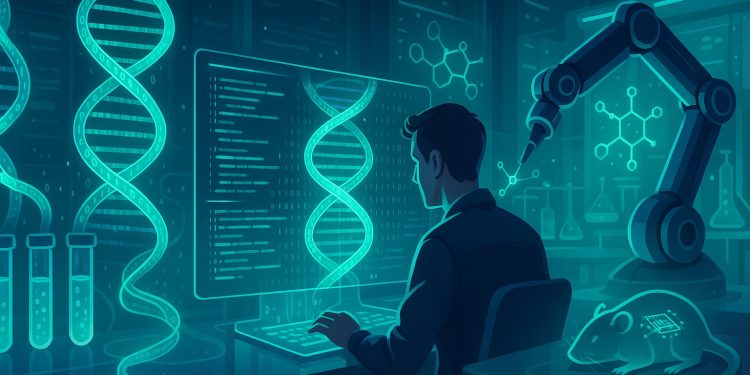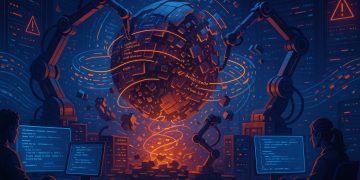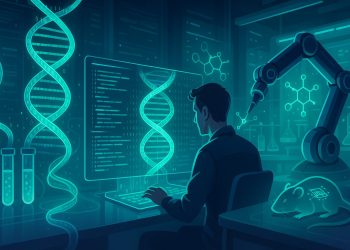The world of computing has always been defined by boundaries — how much data we can store, how fast we can process it, and how efficiently we can move it from one point to another. But today, we stand on the edge of something extraordinary. DNA, the molecule that has been coding life for billions of years, is now stepping into the digital world as the ultimate storage medium. When you combine DNA data storage with bio-computing, you open the door to a future where biology and technology merge, and programmers like you have a front-row seat. This guide will walk you through what this new world looks like, why it matters, and how you can start thinking about coding for living systems.
Why DNA is a Game-Changer for Data Storage
The concept of DNA data storage isn’t just a cool sci-fi idea — it’s rooted in very real science. DNA is, at its core, a data structure. Every living organism is essentially running a program written in four letters: A, T, C, and G. These nucleotides store information at a density far beyond what our current silicon-based storage systems can achieve. To put this into perspective, one gram of DNA can theoretically hold around 215 petabytes of data. That’s thousands of times more storage than the largest data centers today.
As the amount of data we generate grows exponentially — think streaming services, IoT devices, AI training datasets, and the constant flood of digital content — traditional hard drives and cloud servers are starting to hit physical and economic limits. DNA provides a storage medium that is stable for thousands of years if kept in the right conditions, making it ideal for archival purposes.
For programmers, this represents a new frontier. Imagine writing a script today that ends up preserved for centuries without degradation. It’s like version control on a cosmic scale.
Understanding the Basics of DNA Data Encoding
At first glance, DNA might seem foreign, but if you’re a developer, you’re already halfway there. Think of DNA as a base-4 numbering system. Instead of binary 1s and 0s, you have four nucleotides: A, T, C, and G. The process of storing data in DNA involves converting digital binary data into sequences of these nucleotides.
For example, you could assign:
- 00 → A
- 01 → C
- 10 → G
- 11 → T
With this mapping, every two bits of digital data become one nucleotide. Your file is essentially rewritten into a biological sequence. These sequences are then synthesized in a lab, creating physical strands of DNA that contain your data. When you want to read the data back, sequencing machines decode the strands, converting A, T, C, and G back into binary.
From a programming perspective, the encoding and decoding processes resemble working with file compression algorithms or encryption routines. There are even libraries and open-source tools being developed to handle DNA encoding, making it easier for developers to experiment.
Bio-Computing: When Biology Becomes the Processor
Storing data is just one part of the puzzle. Bio-computing takes things a step further by using biological molecules to perform computation. In traditional computing, you rely on CPUs and GPUs made of silicon and transistors. In bio-computing, the “hardware” is living tissue or molecular reactions.
One famous example is a DNA computer that can solve combinatorial problems by exploring multiple solutions simultaneously. Unlike silicon-based systems, DNA strands can replicate, allowing a form of parallel processing that scales naturally. For tasks like optimization problems, this is incredibly powerful.
This might sound abstract, but consider this: biological systems are already masters at parallel processing. Your body runs countless chemical reactions every second, flawlessly coordinated. Bio-computing aims to harness that natural efficiency for digital problem-solving.
DNA Data Storage and Bio-Computing: A Programmer’s Playground
The idea of merging DNA data storage and bio-computing can feel overwhelming at first. As a programmer, you might be wondering, “Where do I fit in?” The answer lies in abstraction. Just like you don’t need to understand the physics of a CPU to write code in Python, you won’t need to be a molecular biologist to code for biological systems — though some basic knowledge will help.
Here’s how programmers can contribute:
- Develop encoding algorithms: Efficient ways to convert binary data to DNA sequences with error correction built-in.
- Create interfaces and tools: Building APIs and software that allow labs and researchers to interact with DNA storage devices.
- Simulate bio-computing processes: Writing models to predict how molecular reactions will behave, similar to simulating network traffic.
- Design secure storage protocols: Since DNA can physically leave a lab, encryption and authentication are critical.
- Data compression innovations: Reducing the amount of DNA needed for storage without losing information.
By focusing on these areas, developers can be part of a groundbreaking field without needing to pipette samples or run gel electrophoresis.
Real-World Applications on the Horizon
This technology isn’t just theoretical anymore. Several companies and research institutions are actively working on DNA-based storage systems. Microsoft and the University of Washington have demonstrated fully automated systems for writing and reading DNA data. Meanwhile, startups are exploring commercial applications for industries like healthcare, space exploration, and digital preservation.
Some exciting use cases include:
- Medical records: Storing lifetime health data directly in biological form, possibly even inside the patient’s own cells.
- Cultural preservation: Archiving art, literature, and history for thousands of years without the risk of digital decay.
- Space missions: DNA is incredibly compact and stable, making it perfect for long-duration missions where every gram matters.
- Secure communications: DNA sequences can be encrypted in ways that are nearly impossible to intercept or replicate without the key.
Imagine a future where libraries are replaced by biological repositories, or where a spacecraft carries not just human DNA but also humanity’s entire digital history.
Challenges in DNA Storage and Bio-Computing
Of course, no frontier comes without challenges. While the potential of DNA data storage and bio-computing is immense, there are several hurdles that need to be addressed before mainstream adoption.
- Cost: Synthesizing and sequencing DNA is still expensive, though prices are dropping rapidly, similar to how Moore’s Law drove down the cost of silicon chips.
- Speed: Writing and reading data from DNA is much slower than using SSDs or cloud storage. Current systems are best suited for archival, not real-time use.
- Error rates: Biological systems are prone to mutations and errors. Error-correcting codes are essential to ensure data integrity.
- Security concerns: Physical DNA samples can be stolen or misused, adding a new layer to cybersecurity challenges.
- Standardization: The lack of universal standards for DNA storage formats and APIs makes interoperability difficult.
The Programmer’s Mindset for the Next Frontier
As a programmer stepping into this new world, you’ll need to think differently. DNA data storage and bio-computing aren’t just about writing efficient code — they’re about bridging digital and biological logic. Here are some mindset shifts to consider:
- Think in analogies: Biology has its own “syntax” and “rules,” similar to programming languages. Learning how to map one onto the other is crucial.
- Embrace interdisciplinary learning: A bit of biology, a bit of chemistry, and a lot of computer science will make you invaluable.
- Prioritize error handling: In biology, errors are natural and expected. Your algorithms must account for this uncertainty.
- Be future-focused: The field is evolving fast. Staying updated on breakthroughs will help you stay ahead of the curve.
Getting Started with DNA Data Storage Coding
If you’re curious about experimenting with DNA data storage concepts, you don’t need a lab right away. There are open-source tools and simulators that let you play with the encoding and decoding process virtually. Some resources to explore:
- Python libraries for bioinformatics like Biopython.
- DNA sequence visualization tools that let you “see” your code.
- Virtual lab environments that simulate DNA synthesis and sequencing.
You can start by writing a simple script to encode a text file into a string of A, T, C, and G. From there, you can explore compression techniques, error correction, and even visual representation of your sequences.
How DNA Data Storage Can Impact Everyday Programming
At first glance, DNA data storage and bio-computing might seem like niche technologies, relevant only to researchers. But history tells us that today’s niche innovations often become tomorrow’s mainstream tools. Just as cloud computing went from curiosity to necessity, DNA-based systems could one day be part of every developer’s toolkit.
Here’s what the future might look like:
- GitHub repositories that store code in DNA libraries.
- Applications that use living organisms as both sensors and processors.
- Cloud providers offering “biological cold storage” alongside traditional options.
The skills you develop now — understanding encoding, error handling, and interdisciplinary problem-solving — will pay dividends as this shift happens.
DNA Data Storage and Bio-Computing: Practical Steps Forward
To truly embrace this next frontier, programmers should focus on practical steps:
- Learn the basics of molecular biology and bioinformatics.
- Experiment with DNA data encoding using open-source libraries.
- Collaborate with researchers or institutions working on bio-computing.
- Stay updated with conferences and journals in synthetic biology and computing.
- Think creatively about how to integrate biological storage into your own projects.
By doing so, you won’t just be a spectator to this revolution — you’ll be an active participant shaping its direction.
FAQs
1. What is DNA data storage?
It’s a way to store digital data in the form of DNA sequences using the four nucleotide bases: A, T, C, and G.
2. How much data can DNA hold?
One gram of DNA can theoretically hold around 215 petabytes of data.
3. Is DNA storage faster than traditional storage?
No, it’s slower and currently best suited for long-term archival purposes.
4. Can programmers work with DNA data storage without a lab?
Yes, through simulators and software tools, you can experiment virtually.
5. Is bio-computing the same as DNA data storage?
No, DNA storage is about saving data, while bio-computing uses biological processes to compute information.













